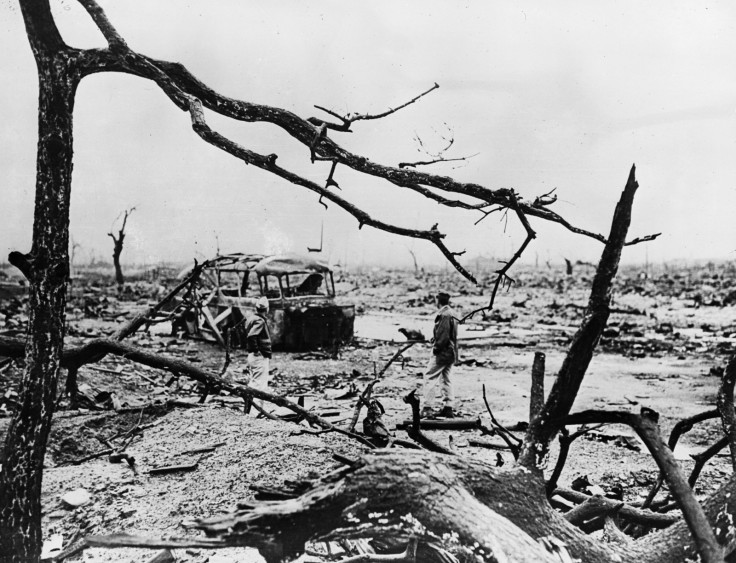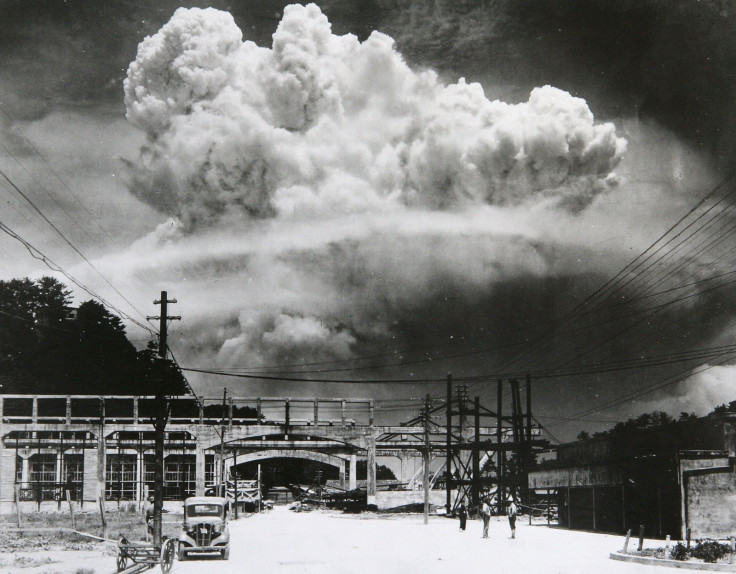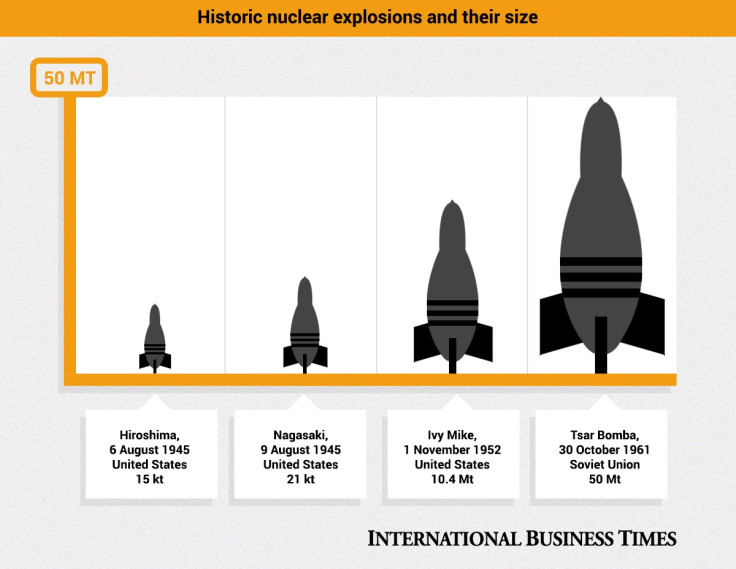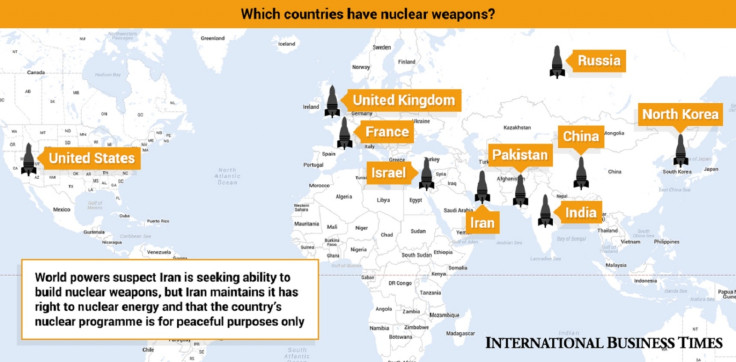Hiroshima and Nagasaki: The rise of the nuclear bomb

On 6 August 1945 the United States dropped an atomic bomb nicknamed Little Boy on the city of Hiroshima in Japan. The fission of slightly less than one kilogram of uranium-235 released energy equivalent to around 15,000 tonnes of TNT, flattening five square miles of the city in seconds.
A second, larger atomic bomb was released over Nagasaki three days later, bringing the final death toll of both attacks, the only times nuclear weapons have been used in war, to an estimated 200,000.
Yet despite the devastation the two bombs unleashed, they are far from the most powerful nuclear weapons ever built. From the first hydrogen device to the Soviet Union's detonation of a weapon with 1,400 times the combined power of Hiroshima and Nagasaki, more than 2,000 nuclear tests have been carried out since 1945.
1939: The Manhattan Project
In October 1939, shortly after the outbreak of the Second World War, US president Franklin Roosevelt received a letter from Albert Einstein and his Hungarian colleague Leo Szilard. It stated a bomb of unprecedented power could be created from the forces of nuclear fission, warning Nazi Germany may be working on creating such a weapon.
Fearing the devastation such a device could yield in Nazi hands, Einstein and Szilard urged the US government to join the race to create the first atomic bomb. The Manhattan Project was launched in 1942 with the co-operation of Britain and Canada and grew to employ more than 130,000 scientists, engineers and workers.
1945: Beginning of the nuclear age
The US government tested its first nuclear weapon, code-named Trinity, in the Jornada del Muerto desert in New Mexico on 16 July 1945. Marking the beginning of the nuclear age, the flash light from the blast – which measured 20 kilotons of TNT – was seen across New Mexico as well as parts of Arizona, Texas and Mexico. Trinity was an implosion-design plutonium device, the same design of weapon that would later be used to devastate Nagasaki.
After witnessing the blast, Julius Robert Oppenheimer, one of the key physicians in the Manhattan Project, later said he recalled a verse from the Hindu text, the Bhagavad Gita. He translated it as: "I become death, the destroyer of worlds."

1945: Hiroshima and Nagasaki
An order was given to drop the atomic bomb on Japan on 25 July. Less than two weeks after the testing of Trinity, the Enola Gay released Little Boy – a gun-type fission weapon fuelled by the nuclear fission of uranium-235 – over central Hiroshima shortly after 8am local time. The 4,400kg bomb took 43 seconds to fall from the aircraft before detonating 2,000ft above the Shima Surgical Clinic.
The city of Nagasaki had been one of the largest seaports in southern Japan and in contrast to Hiroshima, the majority of its buildings had been constructed using wood. Fat Man was larger than Little Boy, weighing over 4,500kg, but the blast was confined to the narrow Urakami Valley, which limited the radius of total destruction.
1946: Anti-nuclear movement
Campaigns against nuclear weapons gained momentum after Hiroshima and Nagasaki, although the movement had been bubbling beneath the surface for some time. At its first resolution in January 1946, the UN General Assembly called for the complete elimination of nuclear weapons and set up a commission to deal with the problem of the atomic discovery.
"Since the invention of nuclear weapons, there have been voices raised to counter them. Physicist and Nobel Peace Laureate Joseph Rotblat left the Manhattan Project over concerns about the weaponisation of the atom," said Susi Snyder, nuclear disarmament programme manager for the Netherlands-based NGO Pax.
What are nuclear weapons?
Nuclear bombs harness the forces that hold the nucleus of an atom together by using the energy released when the particles of the nucleus are split or merged. Nuclear energy can be released from an atom in two ways: nuclear fission and nuclear fusion.
Nuclear fission: The nucleus of an atom is split into smaller fragments by a neutron. Uranium or plutonium isotopes are normally used because their atoms have relatively large nuclei that are easy to split.
Nuclear fusion: Smaller atomic nuclei – usually hydrogen or hydrogen isotopes – are joined to make larger ones. This process happens naturally in stars. Extremely high temperatures and pressures are needed, so all thermonuclear weapons use a fission bomb as a first stage to create the factors needed to start a secondary fusion reaction.
Nuclear weapon yield
Kiloton (kt): A unit of explosive power equivalent to 1,000 tons of TNT
Megaton (Mt): A unit of explosive power – chiefly used for nuclear weapons – that is equivalent to one million tons of TNT
1949: Soviet Union tests its first bomb
The testing of the first bomb built by the USSR was the start of a long relationship between the Soviet Union and nuclear weapons. On 29 August 1949, the Soviets detonated RDS-1, known as First Lightning, at their primary nuclear testing site Semipalatinsk in modern-day Kazakhstan. It had roughly the same yield as Fat Man, around 21 kilotons.
Russia now has a military stockpile of around 4,500 nuclear warheads, according to the Federation of American Scientists.
1952: World's first hydrogen bomb
In the same year the UK tested its first atomic bomb off the coast of Western Australia, the US tested Ivy Mike, the first hydrogen bomb. Introducing the next stage in atomic weaponry, the thermonuclear bomb was around 1,000 times more powerful than its predecessors.
Ivy Mike exploded on the small island of Eniwetok in the Marshall Islands with a yield of 10.4 megatons. Although the bomb placed the US ahead in the nuclear arms race against the Soviet Union, it was a momentary gain – as the Soviets would detonate the largest nuclear device to date less than a decade later.

1954: Bravo test and Lucky Dragon
The US detonation of the 15-megaton hydrogen bomb Castle Bravo remains the largest to be detonated by the US. Intended to be a secret test at Bikini Atoll in the Pacific Ocean, the radioactive fallout from the blast fell onto the neighbouring coral islands Rongelap and Utirik before spreading around the world, sparking international debate about atmospheric nuclear testing. A Japanese fishing boat called Lucky Dragon was also contaminated, killing one crew member.
"The nuclear testing of the 1950s sparked tremendous protest around the world," Snyder said. "The bombing of the Japanese fishing boat Lucky Dragon in 1954 led to the first Japanese organised conferences against atomic bombs – which still draw thousands to Japan each August. The physical effects of testing were felt throughout the world, and prevention was seen as the only possible cure."
1955: Russell-Einstein Manifesto
The Russell-Einstein manifesto was signed by 11 intellectuals and scientists, including Einstein just days before his death. It highlighted the danger posed to the human race by nuclear weapons in the midst of the Cold War:
"Here, then, is the problem which we present to you, stark and dreadful and inescapable: Shall we put an end to the human race; or shall mankind renounce war? People will not face this alternative because it is so difficult to abolish war."
1961: Tsar Bomba
Nicknamed Tsar Bomba, the AN602 hydrogen bomb detonated by the Soviet Union is the largest and most powerful thermonuclear weapon ever created. Former Soviet premier Nikita Khrushchev called it "Kuzka's mother" − a reference to an old Russian saying meaning to teach someone a lesson.
The 50-megaton Tsar was detonated over Novaya Zemlya Island in the Russian Arctic Sea in October 1961, sending a fireball into the sky that could be seen from 600 miles away. The blast contained one quarter of the power of the 1883 eruption of Krakatoa.
One year later, the US discovered Soviet missiles in Cuba, marking the beginning of the Cuban Missile Crisis that brought the US and the USSR to the brink of nuclear war.
1987: Intermediate-Range Nuclear Forces Treaty
The Soviet Union and the US signed a treaty that eliminated all land-based missiles held by the two states with ranges between 300 and 3,400 miles (500 and 5,500 km). Former US president Ronald Reagan and his Soviet counterpart Mikhail Gorbachev put their names to the treaty in the first attempt to reverse the nuclear arms race.
Several years after the break-up of the Soviet Union, Ukraine and other former states gave up their nuclear weapons back to Russia.
2006: North Korea tests for the first time
After troubling the international community for two decades, North Korea's nuclear weapons programme was finally revealed in 2006 in what would be the first of three nuclear detonations.
In 2006, 2009 and 2013, North Korea announced it had conducted successful nuclear tests at Punggye-ri, a nuclear test site in North Hamgyong Province. A tremor measuring magnitude 5.1 was detected by the US Geological Survey indicated the 2013 nuclear test had taken place, but the yield of the weapon is uncertain, with estimates ranging from seven to 16 kilotons.
North Korea's ambassador to China Ji Jae Ryong said at a press conference in July 2015 that the country had no interest in entering Iran-style talks over ending its nuclear weapons programme. Talks are ongoing between Iran and world powers, including the US, over limiting its nuclear programme in exchange for the lifting of some economic sanctions.

2015: How powerful are nuclear weapons now?
For an example of current capacities, the French cruise missiles – ASMP-A – carry 300-kiloton weapons. By comparison, the bomb that flattened Hiroshima released energy of around 15 kilotons.
"In the UK, each submarine carrying the trident system carries approximately 320 times the size of the Hiroshima bomb," Snyder said. "This is 40 warheads, each one at eight times the Hiroshima size."
However, it is difficult to paint a clear picture because of the different compositions of the arsenals in each of the nuclear armed countries. "Some of the weapons – like the ones the US has deployed in Belgium, Germany, Italy, the Netherlands and Turkey – have variable yield capacities," she said.
"The key thing is, any weapon, even the rather rudimentary ones used 70 years ago, can cause catastrophic humanitarian harm. No government or international agency has the capacity to adequately respond to that crisis, and the continued investment into the production and modernisation of these weapons is not justifiable."
© Copyright IBTimes 2025. All rights reserved.




















